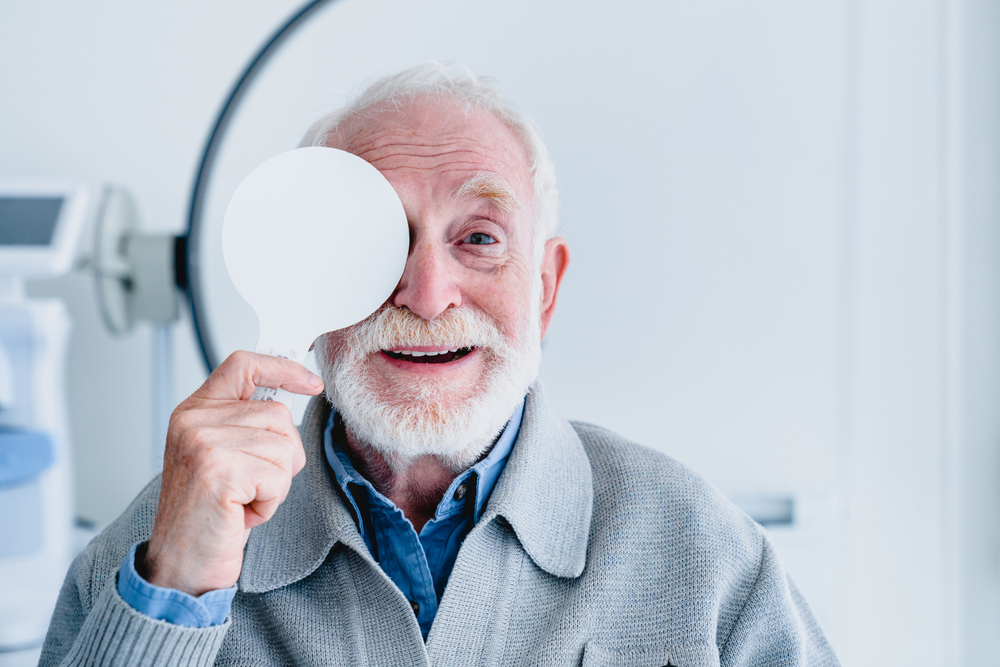Here’s How To Avoid These 3 Types of Age-Related Vision Loss
Posted on Categories Discover Magazine

Age is a risk factor for a host of diseases. Heart disease and stroke, most cancers, osteoarthritis, and, of course, dementia become far more likely as we age. Though we hear about it less often, aging can also be hard on your eyes. Several conditions that affect older people can lead to vision loss and even blindness.
“However, vision loss is not an inevitable part of aging,” explains Roma Patel, associate professor of ophthalmology at Baylor College of Medicine and clinical spokesperson for the American Academy of Ophthalmology.
Here are the most common causes of age-related blindness and what you can do to protect your vision.
1. Cataracts
Cataracts can cause a lot of trouble. The word ‘cataract’ comes from the Latin word for waterfall, and as cataracts progress, it may seem as if you’re looking through a waterfall. Though cataracts can be caused by injury, certain medications, and diabetes, most are age-related, though alcohol consumption, sun exposure, and smoking can cause them to develop faster than they normally would.
Cataracts develop when the proteins in the eye start to break down, a natural part of aging. It’s actually those clumps of proteins that reduce the transparency of the eye lens and make it so hard to see.
According to the National Eye Institute, a part of the National Institutes of Health, more than half of Americans over 80 either have cataracts or have had surgery to correct them. And, of course, that means there’s some good news about cataracts: Surgery to repair them is a very common and generally safe procedure.
Read More: What You Need To Know Before Cataract Surgery
2. Age-Related Macular Degeneration (AMD)
AMD doesn’t cause a complete loss of vision but, instead, a blurring of vision in the central part of the visual field. This occurs when the macula, a part of the retina, is damaged.
There are actually two types of AMD: dry and wet. With Dry AMD, the macula thins and deteriorates, leading to the build-up of drusen, deposits made up of fats and proteins. Dry AMD is more common than wet (about 80 percent of AMD is the dry form), and vision loss is usually gradual. (Dry AMD is different from dry eye.)
Wet AMD is caused by the overgrowth of blood vessels under the retina. These can leak, damaging the macula. It’s less common than dry AMD but more severe, and with wet AMD, loss of vision occurs more quickly.
Early in the course of the disease, AMD doesn’t cause any symptoms. That’s why it’s important to have regular eye exams, especially as you get older.
Read More: How Much Color Do We Really See?
3. Glaucoma
When fluid pressure builds up in the eye, it can damage the optic nerve, causing glaucoma. Like AMD, there are no symptoms in the early stages, but eventually, it causes vision loss, starting with the loss of peripheral vision and progressing to total blindness.
There is no cure, but if caught early enough, it can be controlled either by eye drops that reduce the pressure of fluid on the optic nerve or, in some cases, by laser surgery.
Read More: Our Eyes May Hold Evolutionary Secrets
How to Prevent Age-Related Vision Loss
These are all serious and scary conditions, so you want to do all you can to prevent them. Dr. Patel offers some advice for protecting your eyes. First, never skip your eye exams.
“An ophthalmologist can diagnose eye disease before you notice any changes to your vision and provide treatment before any vision is compromised,” says Patel.
And don’t wait until you get old. The American Academy of Ophthalmology recommends that all adults get an eye exam with an ophthalmologist by age 40.
It’s also important to take care of your health generally.
“High blood sugar can damage the blood vessels in the eye, causing leaks that cause vision loss,” says Patel. “That’s why people with diabetes should get their eyes examined regularly.”
Eating well and exercising regularly help protect your eyes as much as they protect the rest of your body (and mind). Patel recommends eating a wide variety of colorful foods to provide protective antioxidants.
If you smoke, quit; that will reduce your chances of developing cataracts and macular degeneration. And don’t forget to wear your shades.
“It’s very important to wear 100 percent UV-protected sunglasses, even when it’s cloudy out,” says Patel. “UV rays can cause damage to the eye and eventually lead to cataracts or even cancer of the eye.”
If you can’t afford an eye exam, the American Academy of Ophthalmology offers a public program called EyeCare America to help coordinate no-cost eye exams for uninsured seniors or people with a family history of eye disease.
Read More: Is Laser Surgery for Eyes Actually Safe?
Article Sources
Our writers at Discovermagazine.com use peer-reviewed studies and high-quality sources for our articles, and our editors review for scientific accuracy and editorial standards. Review the sources used below for this article:
Avery Hurt is a freelance science journalist. In addition to writing for Discover, she writes regularly for a variety of outlets, both print and online, including National Geographic, Science News Explores, Medscape, and WebMD. She’s the author of “Bullet With Your Name on It: What You Will Probably Die From and What You Can Do About It,” Clerisy Press 2007, as well as several books for young readers. Avery got her start in journalism while attending university, writing for the school newspaper and editing the student non-fiction magazine. Though she writes about all areas of science, she is particularly interested in neuroscience, the science of consciousness, and AI–interests she developed while earning a degree in philosophy.